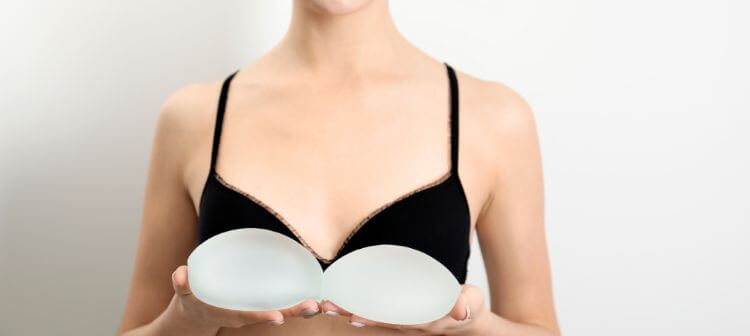Cosmetic surgery trends come and go, and in the early days of breast augmentation, women often wanted larger, attention-grabbing implants. However, Karidis Clinic patients today typically want a more subtle, natural breast enhancement that suits their frame and lifestyle.
Here, we will explore what makes breast implants look the most natural, how to achieve a natural appearance, and potential pitfalls to avoid. We will also discuss alternatives to breast implant surgery.
What are the most natural-looking breast implants?
Choosing the correct type of breast implant is crucial for achieving natural results. The two main options are saline and silicone implants.
- Silicone implants: Silicone implants are known for their natural look and feel. They closely mimic the texture and consistency of natural breast tissue, making them a preferred choice for many. The silicone gel inside the implant gives breasts a softer, more realistic feel, enhancing the overall appearance. These implants come in various shapes and sizes, allowing for a more customised, natural-looking result.
- Saline implants: Saline-filled implants are still the most common implant used in the United States but much less widely used in the UK.
- Gummy bear implants: These are a type of silicone implant that is named after gummy bears because they stay cohesive when cut into. These newer cohesive silicone gels provide a smoother and more natural-looking result; Mr Alex Karidis uses the Motiva cohesive gel implants as he believes this has set a new gold standard.
How can you make your breast implants look natural?
Achieving natural-looking breast implants goes beyond just choosing the right implant type. The following factors play a crucial role:
Consider the placement
Implant placement is a critical factor in achieving natural results. Placing the implant beneath the chest muscle (submuscular) tends to create a more natural appearance, as the muscle provides additional coverage.
Think carefully about the size
Opt for a size that complements your body proportions. Excessively large implants can look less natural, potentially leading to complications and discomfort.
Choose a specialist breast surgeon
A skilled and experienced breast surgeon is vital to ensure a successful outcome. They can guide you in selecting the right implant type and size and perform the surgery with precision.
What can cause breast implants to look fake?
Several factors can lead to breast implants looking fake:
- Poor implant choice: Choosing the wrong type, size, or shape of the implant can result in an unnatural appearance.
- Inadequate placement: Suboptimal implant placement, such as over the muscle, can make the implant edges more visible, resulting in an unnatural appearance.
- Substandard surgical techniques: The skill and expertise of the surgeon are paramount. Inexperienced or inadequately trained surgeons may not achieve the desired natural look.
- Capsular contracture: Capsular contracture is a complication where the scar tissue around the implant tightens, causing the breasts to become firm and less natural in appearance.
What are the alternatives to breast implant surgery?
Breast implant surgery is not the only option for those seeking breast enhancement. Some alternatives include:
Fat Transfer
This procedure involves liposuction to harvest fat from other parts of the body, which is then purified and injected into the breasts. It offers a natural look and feel, with the added benefit of body contouring.
Our breast specialist, Mr Mark Ho-Asjoe, offers fat transfer to the breasts as an alternative to breast implant surgery. A relatively common complication after breast implant surgery is capsular contracture, but the body does not respond in the same way to an autologous fat transfer. Also, the fat that successfully grafts in the breast should remain there permanently, and you will not require further surgery as you may with breast implants.
There are some drawbacks, though, as Mr Ho-Asjoe explains. “Fat transfer is not suitable for someone who wants an immediate increase of several cup sizes; it is more of a gradual process, and you may require a couple of sessions to achieve the fullness you want. With each procedure, you should be able to go up a half to one full cup size.”
Hybrid Breast Augmentation
An increasingly popular alternative is the hybrid breast augmentation, which combines a smaller implant with fat transfer. This allows Mr Mark Ho-Asjoe to sculpt the breast shape in a way that they can’t necessarily do with implants alone. A round implant can be combined with fat transfer to produce a more natural shape and increased volume in the upper part of the breast. Fat transfer can be used to fine-tune the shape and position of the implants, address any asymmetries between the breasts or soften the overall appearance.
A hybrid breast augmentation can also minimise trauma to the breast skin that heavier implants can cause. “By using a smaller implant and then augmenting it with a fat transfer, you are achieving the same effect while doing less damage,” Mark explains.
Breast Lift
A breast lift or mastopexy is ideal for those looking to correct sagging or drooping breasts. It involves removing excess skin and reshaping the breast tissue. Often, a breast augmentation must be combined with a breast lift, otherwise it will produce a less-than-pleasing aesthetic outcome.
Achieving natural-looking breast implants requires careful consideration of implant type, size, placement, and the expertise of your surgeon. Choosing silicone or gummy bear implants, placing them beneath the chest muscle, and working with a skilled surgeon are steps towards achieving a natural appearance.
Understanding the potential pitfalls, such as poor implant choice or inadequate placement, is crucial to avoid fake-looking results. For those seeking alternatives, fat transfer and breast lifts are other surgical options. During your consultation with your Karidis Clinic specialist breast surgeon, they will discuss all your options and advise you on the potential benefits and drawbacks of each procedure.
















